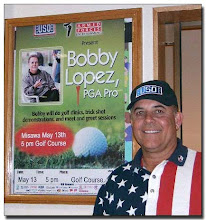Swing Like A Pirate….Use Your ARRRRRMS!
The contribution of the body to the golf swing has been over emphasized for years. I guess one reason for this fact is that body positions were easy to point out in a golf magazine. Problem is, the over use of the body or excess body motion continues to be the killer of the golf swing for many a golfer, holding them back from their true potential.
The biggest killer by far is the starting of your downswing with your shoulders. The body has such a small territory to cover in the downswing while the arms have so far to travel that you MUST start your downswing with your arms or you will travel over the top on your downswing causing you to pull the ball and more importantly release the power angle created at the top of your backswing too early.
Another by product of starting your shoulders first on the downswing is swinging on too steep a plane during your approach to the golf ball. You can get away with swinging a little steep with a wedge up to a seven iron. Once you get in to the longer clubs you need to get the arms going first so the club shallows out on the approach.
The lie angle on a wedge (the lie angle is a measurement from the center of the shaft to the ground in degrees) would be about 64 degrees. On a driver the lie angle is 55 degrees. All clubs are swung on plane, being the shaft angle at address and every golf club has it’s own plane. The longer the golf club the flatter or more shallow the plane. To get the longer clubs to shallow out you need to start your arms earlier on the down swing.
You may feel a little flat or rounded on your swing with a driver but that’s a good thing. A perfect example of what I’m saying here is Sergio Garcia. He starts the arms down early about as well as anyone has since Ben Hogan did. Ben Hogan described his downswing as like pulling an arrow out of a quiver. Tiger Woods says his down swing feels like his arms are falling out of the sky in front of his chest. Al Geiberger said the downswing was like ringing a bell. They are all saying the same thing, get your arms going first in the downswing.
Take a look at Jim Furyk. You may think he has a funny swing but watch how he drops his arms first on the down swing. Many a golfer like Jim Furyk, (Tony Lema, Lee Trevino, Freddy Couples) swing steep on the back swing so they can fall to a shallow position on the downswing. It is a lot easier to fall down to the plane rather than rise up to it. Taking the golf club back low and behind you might cause you to swing steep on the down swing because you need to turn your shoulders first to get the golf club out in front of you to get to the golf ball.
Pretend like you’re facing 12 o’clock while at the address position. Then take your club to the top of the backswing. Pick your head up an look at the 2 o’clock position. Hold that position in your chest and head and start pumping the golf club down with your arms holding the body perfectly still. That’s the feeling you need to get the arms going first.
Another great drill is to put a stick in the ground about three feet high and one foot outside your back foot and even with the golf ball. Try to put the stick in the ground at the same angle as the shaft on your golf club. Take the golf club back outside the stick and bring it down to the ball inside the stick.
Whatever drill you use get your arms going first! Swing like a pirate…use your arrrrrms!
www.bobbylopezgolf.com

